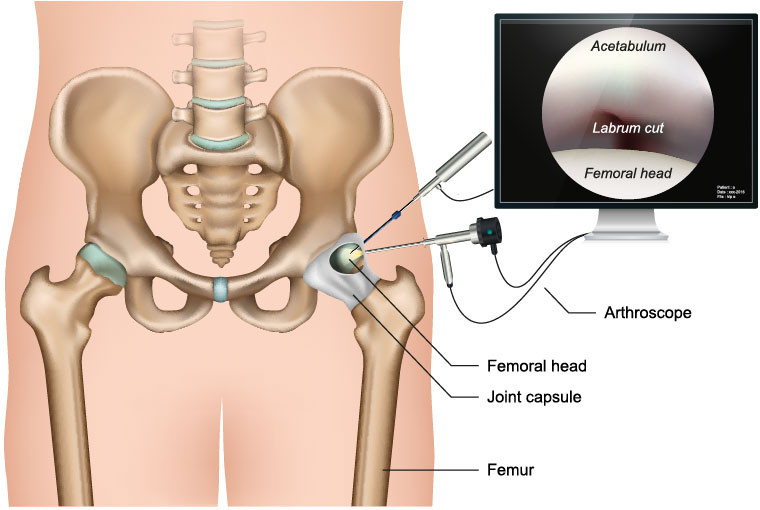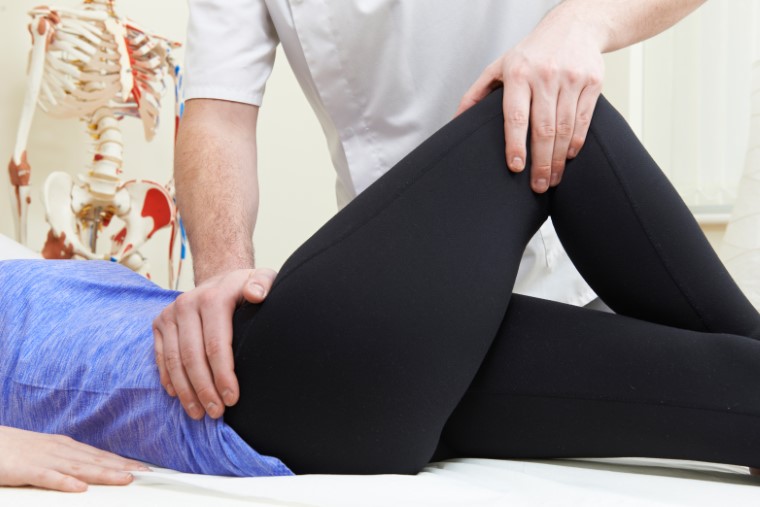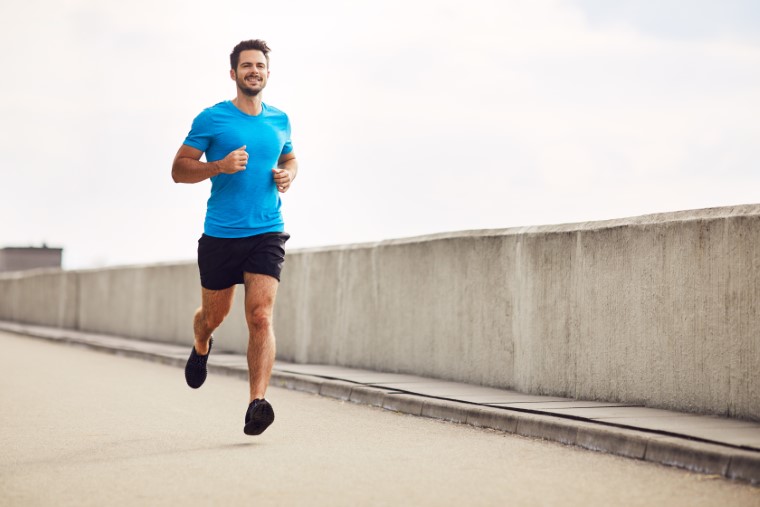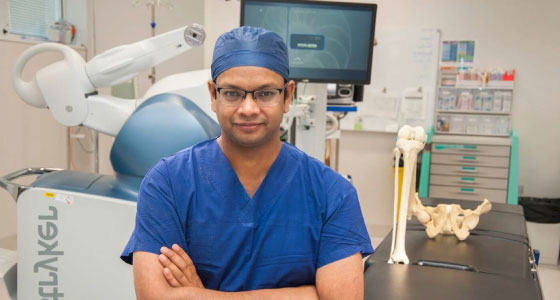Pain and reduced mobility in the hip joint can significantly disrupt your everyday life. There are a number of conditions that may require operative intervention if there is ongoing pain, despite physical therapy, injections and medication.
Many of these conditions can often be effectively treated with key hole surgery of the hip (also known as hip arthroscopy). Please contact us today to book an initial consultation.
What is hip arthroscopy?
Hip arthroscopy is keyhole surgery of the hip joint that's used to observe, diagnose and treat a range of issues. Two to four small incisions are used to place a small camera and instruments inside the joint to perform corrective procedures. It’s a highly specialized technique that’s much less invasive and requires significantly less recovery time than traditional open surgery.

The hip labrum is the soft tissue that covers the acetabulum, which helps the femoral head move smoothly within the socket.
What conditions can be treated by Hip Arthroscopy?
There are a number of hip joint conditions that can be treated with this procedure:
- Hip impingement
- Labral tears
- Dysplasia
- Hip joint cartilage damage
- Ligamentum teres tears
- PSOAS Tendinitis
- Synovitis
- Snapping Hip Syndrome
When is a hip arthroscopy recommended?
If you’ve been suffering from pain and discomfort for a prolonged period of time and non-surgical treatments aren’t proving effective, we would recommend you have a hip arthroscopy. In doing so it will be able to both detect and treat a number of hip joint-related conditions.

A labral tear can often cause groin pain as well as hip problems.
What are the risks?
Hip arthroscopy is generally a safe procedure. The most common side effect of hip arthroscopy is a temporary discomfort, slight bruising or numbness around the foot or groin related to the traction placed on the hip during the procedure.
This is seen in about 5% of cases and usually lasts no more than a few days. Serious complications such as infection, bone fracture or permanent nerve damage or injury are extremely rare. Secondary procedures such as a hip replacement may be required in the future.
How is a hip arthroscopy performed?
Hip joint arthroscopy is usually performed under general anaesthetic and in rare cases, under local anaesthetic. Between 2 and 4 incisions (each approximately 5mm in length), are made around the hip to place the camera and surgical instruments into the hip joint.
How long does a hip arthroscopy surgery take?
The surgery is usually conducted on an outpatient basis (meaning you can return home the same day), and usually takes between 45 minutes and 2 hours, depending on the complexity of the operation.
How long is the recovery?
The recovery largely depends on the operation and will be discussed with you in detail by Dr Chandrasekaran. However, the general recovery timeline is as follows:
Weeks 0 to 4
For the first 4 weeks, you may be required to use crutches (but this may be up to 6 weeks). You may be able to drive a vehicle within a few days as long as you are not taking stronger analgesics and people with desk jobs can return to work within 10 days. Ice packs can be used to alleviate any pain or discomfort.
Weeks 4 to 6
At 4 weeks you’ll be coming off crutches but it may be advisable to use 1 crutch for a few days before coming off altogether. It’s important to start gait training and balance exercises as well as continue to stretch and strengthen the hip muscles.
Weeks 6 to 12
At this stage, you will be able to start a low impact exercise programme (such as swimming or a stationary bike) and work should be done to regain your full range of movement.
After 12 weeks
Higher impact activities such as jogging can be re-introduced at this stage (comfort depending).

Most patients will be able to start low impact exercises after 6 weeks and then return to higher impact activities after 3 months.
Post-Operative and Physical therapy protocol
How much does a hip arthroscopy cost in Melbourne?
The total cost will depend on the exact procedure performed but Dr Chandrasekaran’s staff will provide you with a breakdown of all potential costs and rebates. We can make all the necessary arrangements for you if you decide to have your surgery in the public system. However, please note that there may be a waiting period for the procedure.
Why choose MOATI for a hip arthroscopy procedure?
At MOATI we pride ourselves on our patient-centered approach to quality care. We always aim to devise the best treatment plans suited to your needs and ensure you have the greatest care from the initial consultation all the way through to recovery.

Dr Siva Chandrasekaran
Dr Siva Chandrasekaran is a highly trained Melbourne hip arthroscopy surgeon, having completed prestigious fellowships in the United Kingdom, the United States and Switzerland. He has a special interest in the treatment of hip and knee pain and has published over 50 articles on hip and knee replacement and hip arthroscopy.
FAQs
If you have any more questions about hip arthroscopy, please don’t hesitate to contact us. In the meantime, below are our most frequently asked questions which may also help you.
If you’re suffering from hip pain and have been unable to alleviate it, just a few hours of keyhole surgery could make a huge difference to your everyday life.
If you are in good health there is not much preparation required but Dr Chandrasekaran will discuss all the necessary details at your consultation.
As long as you’re in good health, the surgery is usually conducted on an outpatient basis and you’ll be able to return home the same day as your surgery.
All patients recover differently but for approximately the first 4 to 6 weeks after surgery, you’ll be using crutches. However, after this, you should be able to walk pain-free.
Carrying out the necessary exercises after surgery is vitally important when it comes to the recovery process. Your surgeon will advise you on the do’s and don’ts post-surgery but it’s always advisable to seek additional physical therapy after any operation.
